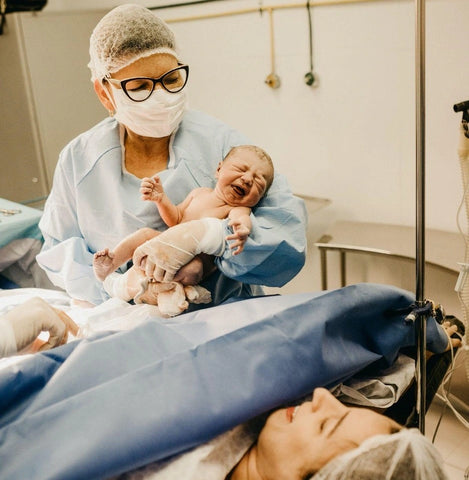The miracle of life occurs in many ways! C-section surrogacy journeys are a uniquely special way to bring a family together. Here’s what you should know!

The journey into surrogacy can be long and winding, and full of unexpected turns. But it can be seen through to it seen with the proper support!
In many cases, a surrogate may prefer a natural birth. However, under particular medical circumstances, a standard delivery may or may not be possible. The reasons are many, although the most important ones revolve around the health and safety of the surrogate and the unborn child.
After all, being a surrogate doesnt mean that you have to take unnecessary risks during pregnancy!
You well-being and safety is paramount during the surrogacy process. If there’s any hint or reasonable chance that a c-section surrogacy journey the safer option for you, then that is the journey to take!
What is a cesarean section?
The definition of a C-section is a pretty straightforward one!
Cesarean sections describe a unique surgical procedure to deliver an infant after the doctor makes minor incisions into the abdomen and uterus. You give birth through these incisions instead of the birth canal.
The rate of c-sections procedures globally continues to rise1 in 5 childbirths are delivered by Cesarean section as of 2021, according to the World Health Organization. However, there are reasons to believe that some of this growth rate puts women at unnecessary risk.
Can you be a surrogate if you’ve already had one?
One question we often hear from potential surrogates is whether or not a previous C-section disqualifies them from surrogacy. We can assure you that this is not the case!
However, the catch is that it’s best to wait at least six months after a C-section before you begin the surrogacy process. Either way, the screening and qualification stages will show you where you stand.
If youre unsure about undergoing another C-section, we can point you in the right direction for medical advice!
Why are cesarean section deliveries sometimes needed?
As we touched upon above, cesarean section deliveries protect the health and safety of the unborn child and the surrogate as well.
A c-section can occur if the baby rests in an abnormal position in the uterus, which would make a vaginal birth significantly riskier.
For example, the baby can be in a breech position, which occurs in 3-4% of pregnancies, meaning that their feet or bottom would enter the birth canal first. The baby’s head will need to be pointed towards the birth canal for a safe birth.
The baby may also be in a transverse position, on their side, with their shoulder leading into the birth canal.
If either situation occurs, please, your doctor may recommend that a cesarean procedure is best! Often, undergoing this type of surgery is necessary to give birth to a healthy child.
What should gestational surrogates expect in case of a C-section?
Having said that, it’s okay to be a little apprehensive about not knowing what to expect if you eventually do need to have a C-section performed! The good news is that the health care you’ll receive during pregnancy monitors whether or not the baby’s health may be at risk.
We’ll do everything we can to help you have a successful surrogacy journey, and that includes explaining C-section surrogacy!
If you think a C-section might be warranted as you go through the pregnancy, the best way to prepare is to educate yourself on the procedure, especially about the recovery time. You may not know that the recovery time after a C-section isn’t very much longer than a traditional birth. A vaginal birth typically requires six weeks to recover; a C-section birth requires eight weeks instead.
With an upcoming c-section in mind, it’s also a good idea to anticipate your basic needs as you begin to heal. You will need to plan ahead for things like:
- Cooking meals
- Doing household chores,
- Working from home during recovery
- ..and anything else you might be responsible for!
This is why having a solid, dependable support system is vital during surrogacy.
It would be best if you didn’t have to go through the recovery process alone, so our staff can tell you what to expect ahead of time.
What should intended parents expect if a surrogate needs to have a C-section?
If you’re an intended parent and your surrogate requires a C-section, rest assured that it’s a common procedure with an excellent success rate. A doctor may recommend a C-section as a precaution when certain risk factors are high.
For instance, if you have multiple births, you can choose a vaginal birth, but there’s a greater risk of one of the babies turning into an abnormal position during labor.
No matter what, the best thing intended parents can do is be supportive should the throughout the surrogate’s journey!
What’s the relationship between C-section delivery rate and BMI?
Intended parents and surrogates might be curious about how Body Mass Index, or “BMI”, affects the success rate of c-section deliveries.
Research shows that undergoing a C-section is more likely as a woman’s BMI increases. Still, that doesn’t mean having a perfect BMI precludes you from ever needing a C-section. It only means that you’ll have a greater chance of experiencing a natural vaginal birth if you have a healthy BMI.
Ultimately, there’s no need to feel nervous about C-sections because they’re standard procedures with a pretty high success rate and a reasonable recovery period too. If you have any other questions about C-section surrogacy, reach out to us to learn more about the facts.
Ready to start a beautiful family, and want to speak with a surrogacy advisor? Contact us today!
Sources:
https://my.clevelandclinic.org/health/diseases/21848-breech-baby
https://www.who.int/news/item/16-06-2021-caesarean-section-rates-continue-to-rise-amid-growing-inequalities-in-access
https://www.mayoclinic.org/tests-procedures/c-section/about/pac-20393655
https://pubmed.ncbi.nlm.nih.gov/23477241/





